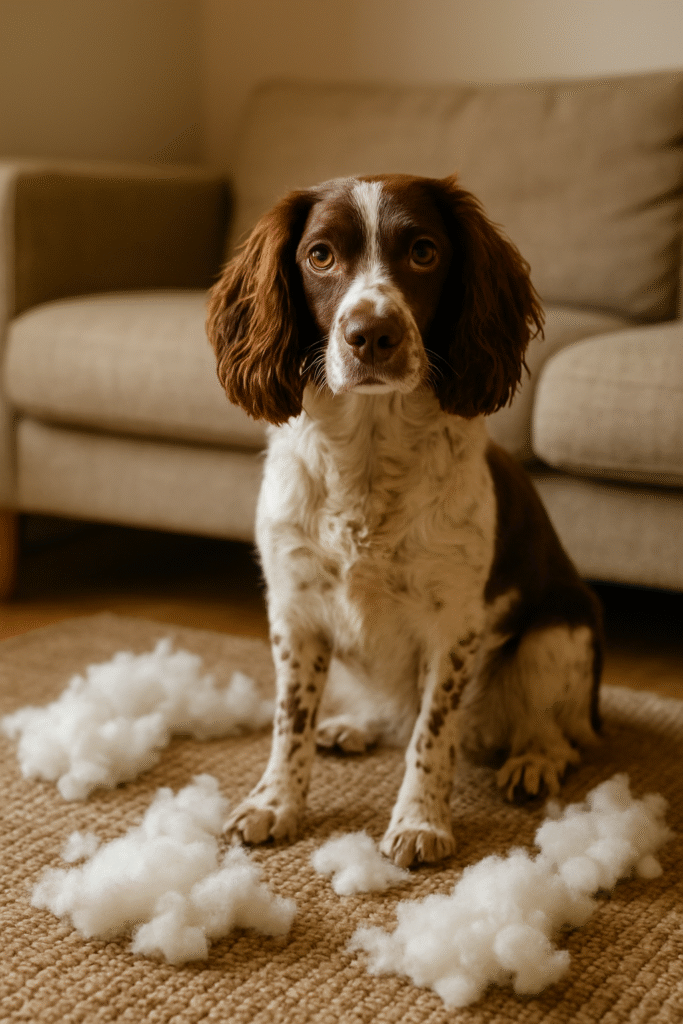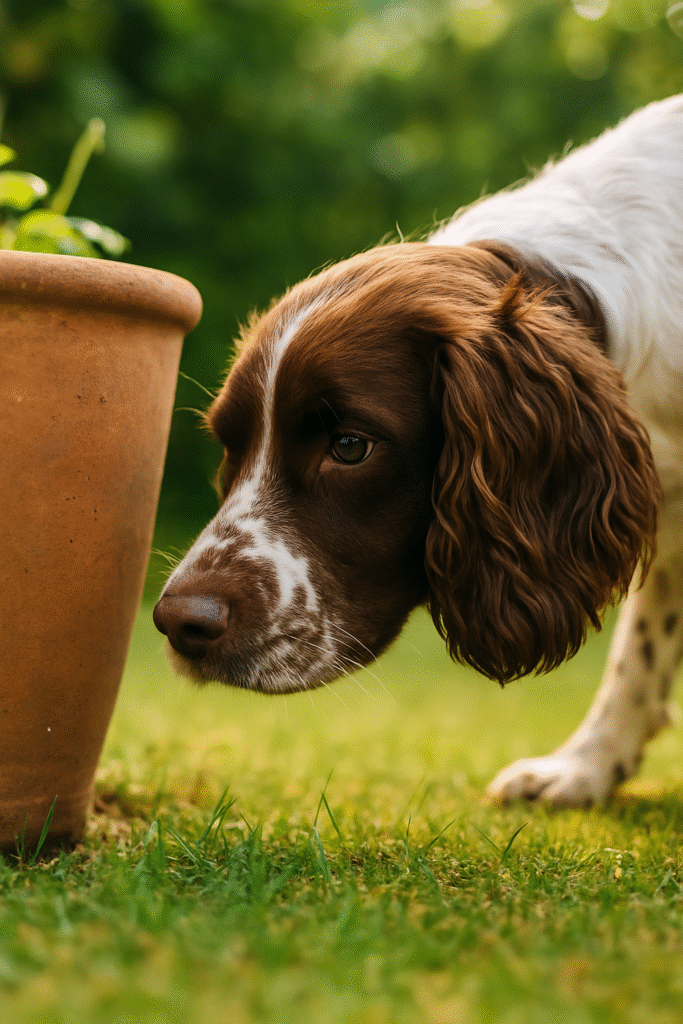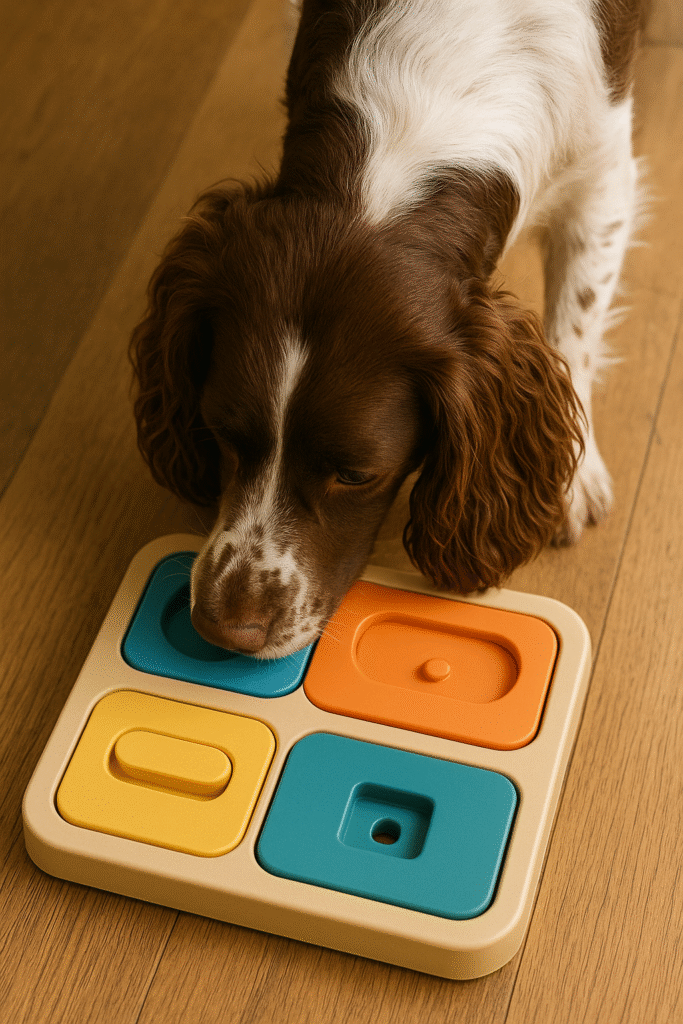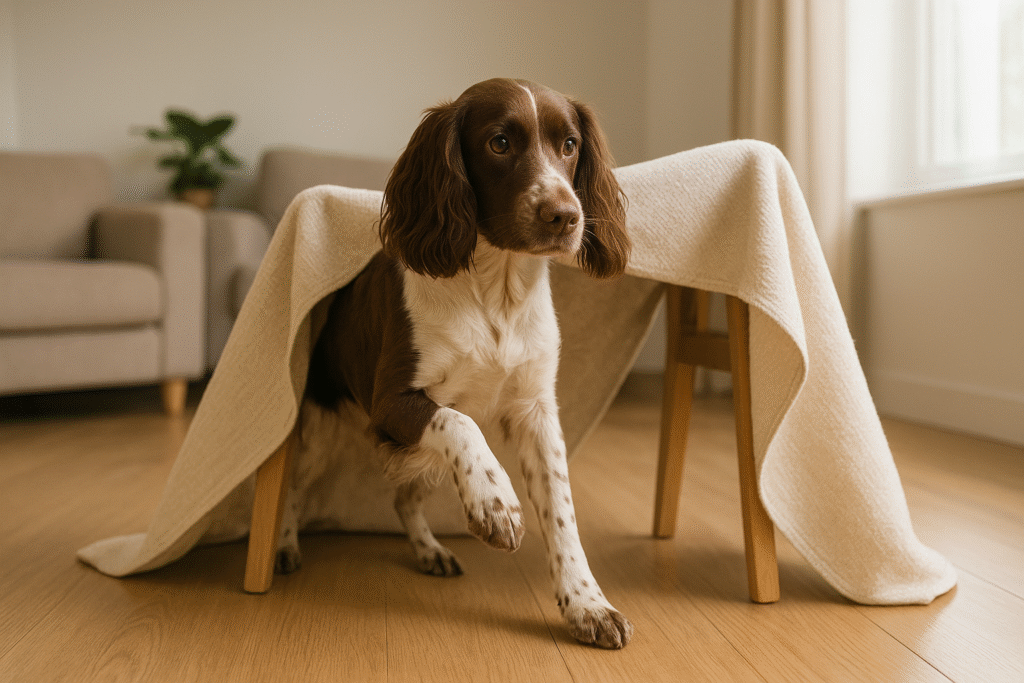
Oh, I know that look. That slightly wild-eyed expression of a working cocker spaniel owner who’s just discovered what their “angel” got up to while they popped to the shops. Maybe it was your favourite pair of shoes that got the full makeover treatment. Perhaps you came home to find your sofa had been “redecorated” with stuffing. Or worse – that mysterious crater in the garden that definitely wasn’t there this morning.
I’ve been there. We’ve all been there!
In fifteen years of working with gundogs, I’ve lost count of the number of times during consultation, owners are practically in tears, asking “What am I doing wrong?” The answer is usually nothing. You’re not failing your dog. Your cocker isn’t being spiteful or vindictive. And no, getting another dog “for company” probably won’t solve the problem (trust me on that one).
What you’ve got on your hands is a bored genius. And bored geniuses, whether they’re toddlers or working cockers, tend to find their own entertainment.
The Truth About Your Cocker’s “Naughty” Brain
Here’s what we fail to remember when we fall in love with those sweet puppy dog eyes and adorable oversized ears. Working cockers were bred to be thinking dogs. Not just running-about-having-a-laugh dogs, but proper, decision-making, problem-solving partners.
For generations, their ancestors spent their days reading the wind, tracking scents through complex terrain, making split-second decisions about whether that rustle in the bushes was worth investigating. They worked alongside their handlers like furry business partners, each trusting the other’s expertise.
Then we bring them home to our orderly domesticated lives and… well, what exactly are they supposed to do with all that brainpower? Watch daytime TV?
Your cocker’s destructive behaviour isn’t rebellion – it’s their brilliant mind saying “Right then, if you won’t give me a job to do, I’ll find my own.” Unfortunately, their idea of a stimulating project rarely matches ours. That antique coffee table leg? Perfect for testing bite strength and wood density. Your vegetable patch? An excellent archaeological dig site with bonus sensory experiences.
I always tell my clients: fifteen minutes of proper mental work will knacker a cocker more than an hour of tennis ball chasing. Their brains are like high-performance engines – they need the right fuel and regular, challenging work to function properly.
Game 1: Scent Work & Treasure Hunts
(AKA “Finally, A Proper Job!”)
This one’s my absolute favourite because it turns your daily walks into something your cocker will actually find exciting instead of just… well, walking.

You’ll need a few different treats or small toys – I use chunks of cheese, bits of sausage, a squeaky ball, maybe a favourite rope toy. The key is variety in scent and texture.
Start stupidly simple in your garden. Show your cocker a piece of cheese, let them have a good sniff, then hide it behind a plant pot while they watch. Say “Find your treasure!” in your most excited voice (yes, you’ll feel daft, but they love it). When they find it – and they will in about two seconds – act like they’ve just discovered buried pirate gold.
Once they’ve got the hang of it, hide treats before you even call them outside. Progress to multiple hiding spots, different rooms, even upstairs if you’re feeling brave. I’ve got clients whose cockers now methodically search the entire house for hidden treasures while they’re making morning coffee.
The brilliant thing is you can adapt this anywhere. Rainy day? Hide treats around the living room. Short on time? Five minutes in the back garden still counts. One client of mine hides toys in her car before long journeys – keeps her cocker happily occupied for miles.
Fair warning: once you start this, your cocker will expect every walk to be an adventure. But honestly? Seeing them use their nose properly, watching their tail go mental when they find something – it’s worth becoming the slightly eccentric person who talks to their dog about hidden treasure.
Game 2: Make Mealtimes Work For Their Living
Here’s a simple change that can make a massive difference – turn one of your cocker’s daily meals into brain work instead of a thirty-second scoff-fest.
You don’t have to overhaul everything at once. Keep their morning bowl normal if you’re rushed getting ready for work, but make their evening meal something they have to work for. Working cockers are too smart and too energetic to just get everything handed to them on a plate.
Don’t worry if you don’t have a fancy puzzle feeder (though they are great). An old muffin tin with tennis balls covering each cup works brilliantly. Scatter their kibble underneath and watch them work out how to move the balls.
My personal favourite DIY version? Toilet roll tubes stuffed with kibble, ends folded shut, scattered around the garden. Costs nothing, keeps them occupied for ages, and gives them the satisfaction of “killing” their prey before eating it. Very satisfying for a working dog.
For the advanced course, try a “snuffle mat” – just a rubber doormat with fleece strips poked through the holes. Scatter dry food throughout and let them forage like they would in the wild. You can make one while watching telly; takes about an hour and lasts for years.

The transformation is immediate. A cocker who’s worked for breakfast is a calm, settled cocker for the rest of the morning. Compare that to the manic energy of a dog who’s wolfed down a bowl of food in thirty seconds flat.
Rotate different puzzle types so they can’t just learn the system. Keep them guessing. Keep them working. Keep them tired.
Game 3: The “Clever Clogs” Name Game
This one makes people think you’ve got some sort of canine genius living with you. Which, to be fair, you probably do.
Working cockers are absolute naturals at learning toy names because it combines everything they love: using their mouth, making you happy, and showing off how clever they are.
Start with two completely different toys – say, a rope and a ball. Hold up the rope, say “rope” clearly, and when they take it, make a massive fuss. Do this a few times, then try with the ball and “ball.” Keep the sessions short – five minutes max, or their brain will start switching off.
Once they reliably take the right toy when you name it, put both on the floor and ask for one specifically. The moment they bring you the correct one, act like they’ve just performed actual magic. Because in a way, they have.
I’ve got cockers who know twenty-plus toy names. They’ll disappear upstairs and come back with exactly what you asked for, looking incredibly pleased with themselves. And why shouldn’t they? It’s proper impressive.
The real magic happens when you start asking for toys that are in different rooms. Watching a cocker methodically search the house for “blue ball” while ignoring three other balls is something special. It’s proper problem-solving behaviour, exactly what their brains are designed for.
One word of caution – be prepared for them to become slightly obsessed with this game. I’ve got clients whose cockers now bring them random toys throughout the day, just hoping for a naming session. Worse problems to have, really.
Game 4: Advanced Scent Work
Right, let’s talk about your cocker’s superpower – that incredible nose that’s currently being wasted on finding dropped biscuits and investigating other dogs’ business.
Working cockers can distinguish between thousands of different scents. Thousands. And most of them spend their lives smelling nothing more challenging than their dinner bowl. It’s criminal, really.
Start simple with different food smells – a piece of cheese in a small container, some sprats in another, maybe a bit of cooked chicken. Hide the scented container somewhere easy and teach them to “find the cheese.” When they do, massive celebration. You know the drill by now.
Progress to hiding different scents without them seeing where they go. Then try multiple scents at once and ask for a specific one. Advanced level: hide a family member in the garden and teach “find Dad.” My own cocker once tracked my husband down three streets away after he’d gone for a run. Slightly embarrassing, but undeniably impressive.
The outdoor version is even better – walk ahead on familiar routes and drop small treats every few metres, then come back and encourage them to follow your trail. They’ll put their nose down and work like proper tracking dogs. You’ll feel like you’re in a wildlife documentary.
Here’s what I love about scent work: it’s properly tiring. Not the manic, overstimulating tired you get from endless ball throwing, but the good, satisfied tired that comes from using your brain properly. Your cocker will sleep like a baby afterwards.
Game 5: The “Thinking Dog’s” Obstacle Course
This isn’t about creating some elaborate agility setup (though if that’s your thing, crack on). This is about giving your cocker puzzles to solve, challenges that make them think “How do I get from A to B?”
Use whatever you’ve got – cushions to weave through, chairs with a blanket over for a tunnel, a plank between two sturdy boxes for a bridge. The point isn’t athletic achievement; it’s mental problem-solving. How do I get over this? Under that? Around this thing?

Add puzzle boxes to the mix – shoeboxes with loose lids containing treats, containers with different latches or rope pulls. Each box should need a slightly different approach. Watch your cocker work out that this one needs pushing, that one needs pulling, this one needs both.
My favourite advanced challenge is multi-stage problems. Ring a bell to get me to open a cupboard. Solve the puzzle inside to get the reward. It sounds complicated, but cockers pick this up scary fast.
Change things weekly. Keep them guessing. The moment they start going through the motions without thinking, switch it up.
I had one client whose cocker got so good at problem-solving that he learned to open the kitchen cupboards and help himself to treats. Had to put child locks on everything. Success story or epic fail? You decide.
Just Pick One (Seriously, Just One)
Look, I know I’ve just thrown a lot at you. Five different games, multiple variations, all while you’re probably looking at the remains of whatever your cocker destroyed today and thinking “I can barely manage walks, never mind turning into some sort of canine entertainment director.”
Here’s the thing – you don’t need to do everything at once. Pick one game. Just one. The one that sounds least like hard work to you.
If you’re always rushed, start with puzzle feeders. You have to feed them anyway, might as well make it work for you both.
If you love your daily walks but they’ve become a bit routine, try treasure hunts. Your regular route will suddenly become the highlight of your cocker’s day.
If you’re competitive and quite like showing off, go for the name game. Nothing beats the smug satisfaction of casually asking your dog to “fetch the red rope toy from upstairs” in front of guests.
The changes happen faster than you’d think. Most of my clients notice a difference within a week. Suddenly there’s less destruction, less manic energy, more of that lovely, settled behaviour we all want from our dogs.
Your working cocker isn’t broken. They’re not badly behaved or spiteful or any of the other things frustrated owners tell themselves at 3am when they’re clearing up the latest mess. They’re just desperately, desperately bored.
Give them something proper to do with that magnificent brain, and I promise you’ll start seeing the dog you always knew was hiding under all that misdirected energy. The clever, loyal, absolutely brilliant companion who’s been waiting for you to give them a real job.
Your curtains will thank you. Your sanity will thank you. And your cocker? Well, they’ll finally be the happy, fulfilled working dog they were always meant to be.
Now stop reading and go hide some cheese.
